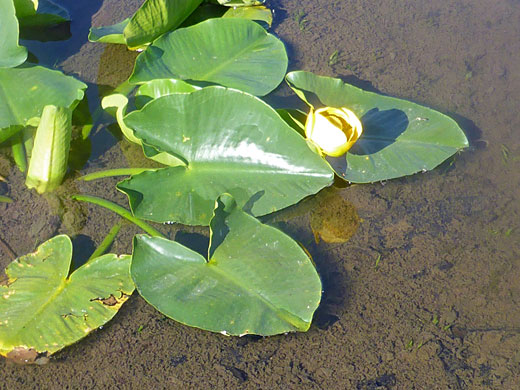Common name:
Great yellow pond-lily
Family:
Scientific name:
Nuphar polysepala
Main flower color:
Range:
The Pacific states, the Rocky Mountain states, northwest Nevada and north Arizona
Height:
A few inches - grows in water
Habitat:
Lakes, ponds, slow-moving streams, from near sea level to 10,000 feet
Leaves:
Round to ovate, up to 15 inches long, on stalks of up to 40 inches
Season:
May to August
Nuphar polysepala is one of the easiest western US plant species to identify, especially when in bloom. The distinctive yellow flowers are up to 4 inches in diameter, formed of between seven to nine (occasionally up to 12) overlapping sepals, forming a cup-shape, enclosing a yellow, disc-shaped stigma up to 1.5 inches across ringed by numerous red-purple stamens, beneath which, largely hidden, are between 10 and 20 small petals. The sepals have a waxy surface texture, and may be tinged with red or green towards the base.
This is an aquatic species, growing in still or slow-moving water; the petals are held at or slightly above the surface, while the leathery leaves are floating. The leaves are heart-shaped, with two backwards projections (lobes) at the base. The leaf stalk is usually much longer than the blade. Plants grow from large rhizomes, up to 15 feet long.
This is an aquatic species, growing in still or slow-moving water; the petals are held at or slightly above the surface, while the leathery leaves are floating. The leaves are heart-shaped, with two backwards projections (lobes) at the base. The leaf stalk is usually much longer than the blade. Plants grow from large rhizomes, up to 15 feet long.
All Contents © Copyright The American Southwest | Comments and Questions | Contribute | Site Map




